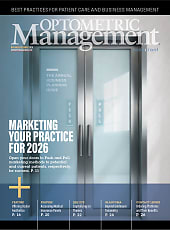A new analysis from the Bifocal Lenses in Nearsighted Kids (BLINK) Study revealed that subfoveal choroidal thickening occurs within 2 weeks of initiating high-add (+2.50 D) multifocal contact lens (MFCL) wear in myopic children, and is maintained over a 3-year period. These changes were significantly associated with reduced axial elongation and accounted for up to 29% of the overall myopia control effect.
The BLINK study was a 3-year, double-masked randomized clinical trial that was conducted across 2 US academic sites. A total of 281 myopic children aged 7 to 11 years were randomly assigned to wear one of three lens types:
- Single-vision contact lenses (SVCL)
- +1.50 D center-distance MFCL
- +2.50 D center-distance MFCL
Baseline subfoveal choroidal thickness and area were measured using spectral-domain optical coherence tomography (OCT), and follow-up imaging was conducted after 2 weeks of lens wear and then annually for 3 years.
After the initial 2 weeks, children wearing +2.50 D MFCLs demonstrated an average increase in subfoveal choroidal thickness of 8 μm ± 3 μm (P=.003) and choroidal area of 0.07 ± 0.02 mm² (P=.002) compared with SVCL wearers. No significant changes were observed in the +1.50 D MFCL group compared with SVCLs (P≥.25).
The increases in choroidal thickness and area in the +2.50 D MFCL group compared with the SVCL group were maintained through the end of the study by averages of 7 μm ± 3 μm (P=.01) and 0.06 ± 0.02 mm2 (P=.003), respectively. Regional increases in choroidal area were observed in the superior, inferior, and temporal subfields, but not nasally.
The study modeled how short-term choroidal changes related to long-term eye growth. The researchers found that each micron of choroidal thickening at 2 weeks was associated with 0.0058 mm less axial elongation over 3 years in the +2.50 D MFCL group compared with the SVCL group (P=.02). They also noted −0.947 mm less axial growth over 3 years per square millimeter of thickening after 2 weeks of lens wear compared with the SVCL group (P=.006).
“The average initial subfoveal choroidal thickening of 8 µm after wearing +2.50 D MFCL for 2 weeks only accounted for 20% of the 0.23-mm, 3-year decrease in axial growth. Similarly, the average initial increase in choroidal area in children wearing +2.50 D MFCL of 0.07 mm2 accounted for 29% of the 3-year decrease in axial growth,” the authors reported.
Final axial length was inversely associated with choroidal thickness and area in the +2.50 D MFCL group, but the clinical magnitude was modest.
The study’s findings support a partial mechanistic role of the choroid in the efficacy of high-add MFCLs for myopia control, the authors noted. However, the choroidal thickening explains only a fraction of the treatment effect, and the high within-group variability in choroid measurements suggests limited predictive value for individual patient outcomes in clinical settings.
Limitations included diurnal and seasonal variation in choroidal thickness that was not fully controlled, although visit timing was consistent. Magnification correction in imaging relied on refractive error and corneal curvature, not axial length, and environmental and behavioral factors (eg, hydration, caffeine, near work) were not standardized prior to imaging.
A full list of author disclosures can be found in the original publication.



